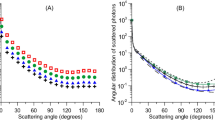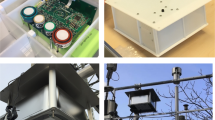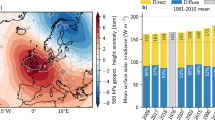Abstract
Layering in the Earth's atmosphere is most commonly seen where parts of the atmosphere resist the incursion of air parcels from above and below — for example, when there is an increase in temperature with height over a particular altitude range. Pollutants tend to accumulate underneath the resulting stable layers1,2,3,4,5, which is why visibility often increases markedly above certain altitudes. Here we describe the occurrence of an opposite effect, in which stable layers generate a layer of remarkably clean air (we refer to these layers as clean-air 'slots') sandwiched between layers of polluted air.
Similar content being viewed by others
Main
We have observed clean-air slots in various locations around the world, but they are particularly well defined and prevalent in southern Africa during the dry season (August–September). This is because at this time in this region, stable layers are common and pollution from biomass burning is widespread.
We were readily able to identify clean-air slots from our research aircraft by looking towards the horizon as our altitude changed. Visibility was very limited in the polluted air above and below a slot, but increased suddenly and markedly upon entering the clean air. The clean-air slot thus appears momentarily as a thin, white, horizontal layer (Fig. 1).
In 26 flights over southern Africa during a period of 6 weeks, we saw 12 well defined clean-air slots. These were most commonly encountered in the morning, a fact that is probably explained by heating of the ground during the day, with a resulting increase in convective activity which causes stable layers to dissipate. During the night, as the land cools, stable layers and clean-air slots can be re-established.
All of the clean-air slots occurred within narrow regions a few hundred metres thick, where the atmosphere was stable and the air was very dry; they were generally located about 2 km above sea level. The particle concentrations contained in these slots were only about one-third of those measured in the polluted air above and below them.
In southern Africa, pollution beneath these clean-air slots is produced as a result of widespread biomass burning, and is augmented by industrial emissions. The polluted air above the slot probably derives from pollutants that have been carried up by convective activity in regions that are not dominated by stable layers. Once in this higher band, the polluted air can presumably be transported horizontally over large distances.
Stable layers are common in southern Africa during the dry season, because of the occurrence of atmospheric subsidence6. If the subsiding air originates high in the troposphere, it will generally be clean and dry. The subsiding air thus has both of the principal attributes of a clean-air slot. In addition, the dryness of the air will enhance visibility, because the particles will be devoid of condensed water7. The stability of the layer of subsiding air to intrusions of polluted air from both below and above will cause it to retain its pristine state. The horizontal transport of layers of clean marine air may also have been responsible for some of the clean-air slots that we observed.
References
Wu, Z. et al. J. Geophys. Res. 102, 28353–28365 (1997).
Swap, R. J. & Tyson, P. D. S. Afr. J. Sci. 95, 63–71 (1999).
Newell, R. E. Nature 398, 316–319 (1999).
Garstang, M. et al. J. Geophys. Res. 101, 23721–23736 (1996).
Cho, J. Y. N. et al. Geophys. Res. Lett. 28, 3243–3246 (2001).
Tyson, P. D. & Preston-Whyte, R. A. The Weather and Climate of Southern Africa (Oxford Univ. Press, Cape Town, 2000).
Kotchenruther, R. A. & Hobbs, P. V. J. Geophys. Res. 103, 32081–32089 (1998).
Author information
Authors and Affiliations
Corresponding author
Ethics declarations
Competing interests
The author declares no competing financial interests.
Rights and permissions
About this article
Cite this article
Hobbs, P. Clean air slots amid atmospheric pollution. Nature 415, 861 (2002). https://doi.org/10.1038/415861a
Issue Date:
DOI: https://doi.org/10.1038/415861a
Comments
By submitting a comment you agree to abide by our Terms and Community Guidelines. If you find something abusive or that does not comply with our terms or guidelines please flag it as inappropriate.




